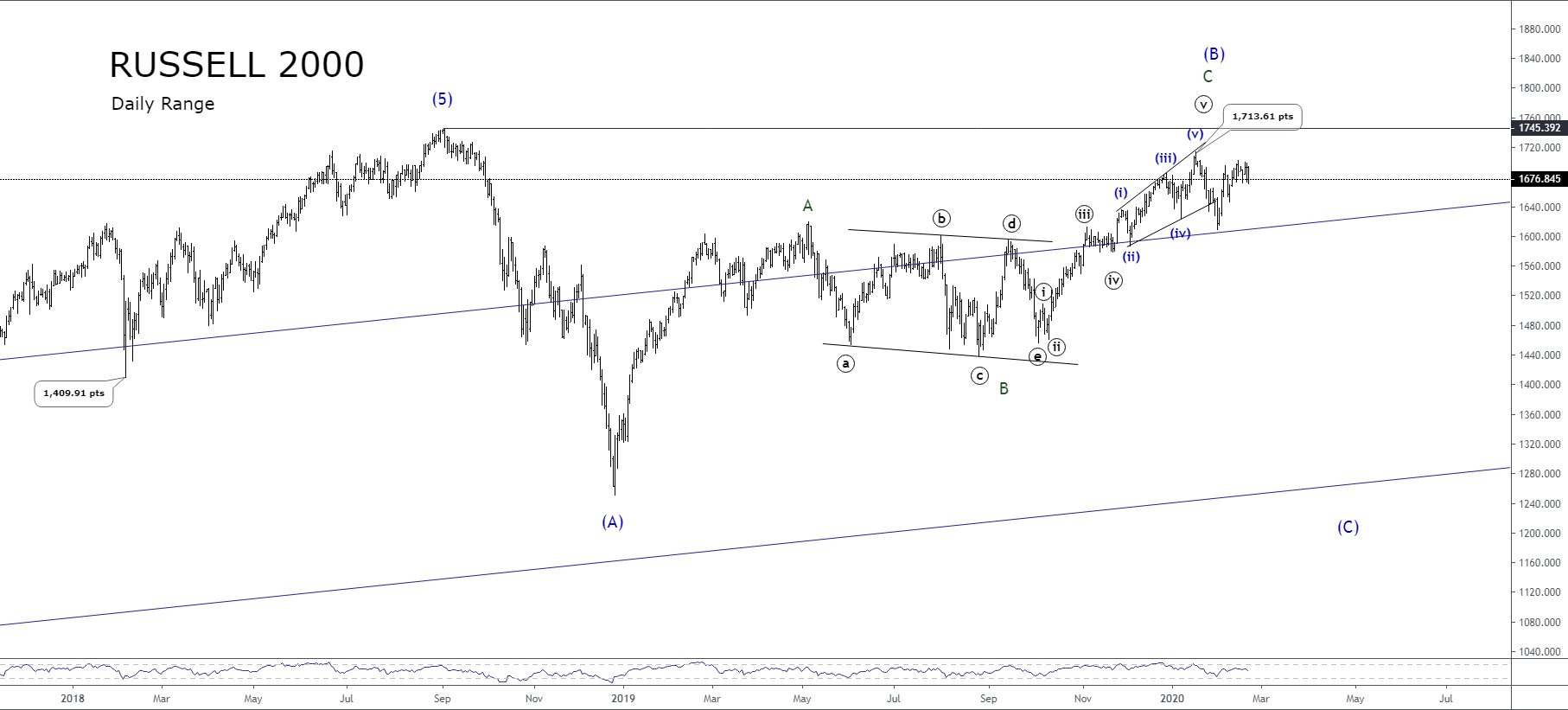The stock market participants show increasing its pessimistic sentiment aided by the growing developments on the coronavirus epidemic, which is fueling the fears of a global economic slowdown. However, the Elliott wave perspective seems to be anticipating an escalating "bad news."
Looking at the Russell 200 log-scale weekly chart from an Elliott wave perspective, we observe the bullish cycle that began in early March 2009 when Russell found fresh buyers at 341.76 pts.
Russell 2000 completed a five-wave sequence of Intermediate degree in early September 2018, once the U.S. index reached at 1,745.3 pts.
According to the channeling method described by the R. N. Elliott, the projection of the ascending trendline between the end of waves (2) and (4), on the high of wave (3) creates a channel whose upper border provides the potential end of the fifth wave.
We see on the chart that the fifth wave of Intermediate degree labeled in blue didn't surpass the upper-line of the channel. However, the decline developed by the low-cap index, dropping below the previous swing low located at 1,409.91 pts., gives us one clue that this rally that started in 2009 has probably
come to an end. We can observe that this decline, which is identified as wave (A) of Intermediate degree, evolved in three internal waves.
The next move, corresponding to wave (B) illustrated in the following chart, looks like a three-wave sequence, which could have ended on January 17th, when Russell topped at 1,713.61 pts.
On the second chart, we distinguish that wave (B) of intermediate degree corresponds to a zigzag pattern. This sequence subdivided in 5-3-5, began with the 2018 Santa Claus rally when the index found buyers at 1,250.90 pts.
The wave B of Minor degree labeled in green resembling a triangle pattern was finished in early October 2019, when Russell began its last rally that ended on January 17t, at 1,713.61 pts.
In the same chart, we can observe the ascending five-wave sequence, which developed its fifth wave of Minute degree labeled in black moving in an expanding ending diagonal pattern.
According to the Elliott wave theory, an ending diagonal pattern is an impulsive formation having a 3-3-3-3-3 sequence, and it is commonly found in wave 5 or c.
Summarizing, since the corrective formation holds a first move developed in three waves, and the second ascending movement follows a three-wave sequence, the structure in progress could correspond to a flat pattern. The next step should develop in five waves.
In consequence, according to the potential flat pattern in progress, and considering that the next move should be a bearish wave C of Minor degree, our preferred bias is in the short side.
Risk Warning: CFD and Spot Forex trading both come with a high degree of risk. You must be prepared to sustain a total loss of any funds deposited with us, as well as any additional losses, charges, or other costs we incur in recovering any payment from you. Given the possibility of losing more than your entire investment, speculation in certain investments should only be conducted with risk capital funds that if lost will not significantly affect your personal or institution’s financial well-being. Before deciding to trade the products offered by us, you should carefully consider your objectives, financial situation, needs and level of experience. You should also be aware of all the risks associated with trading on margin.
Recommended Content
Editors’ Picks

EUR/USD hits two-week tops near 1.0500 on poor US Retail Sales
The selling pressure continues to hurt the US Dollar and now encourages EUR/USD to advance to new two-week peaks in levels just shy of the 1.0500 barrier in the wake of disappointing results from US Retail Sales.

GBP/USD surpasses 1.2600 on weaker US Dollar
GBP/USD extends its march north and reclaims the 1.2600 hurdle for the first time since December on the back of the increasing downward bias in the Greenback, particularly exacerbated following disheartening US results.

Gold maintains the bid tone near $2,940
The continuation of the offered stance in the Greenback coupled with declining US yields across the board underpin the extra rebound in Gold prices, which trade at shouting distance from their record highs.

Weekly wrap: XRP, Solana and Dogecoin lead altcoin gains on Friday
XRP, Solana (SOL) and Dogecoin (DOGE) gained 5.91%, 2.88% and 3.36% respectively on Friday. While Bitcoin (BTC) hovers around the $97,000 level, the three altcoins pave the way for recovery and rally in altcoins ranking within the top 50 cryptocurrencies by market capitalization on CoinGecko.

Tariffs likely to impart a modest stagflationary hit to the economy this year
The economic policies of the Trump administration are starting to take shape. President Trump has already announced the imposition of tariffs on some of America's trading partners, and we assume there will be more levies, which will be matched by foreign retaliation, in the coming quarters.

The Best Brokers of the Year
SPONSORED Explore top-quality choices worldwide and locally. Compare key features like spreads, leverage, and platforms. Find the right broker for your needs, whether trading CFDs, Forex pairs like EUR/USD, or commodities like Gold.

